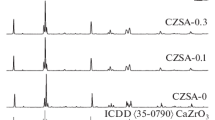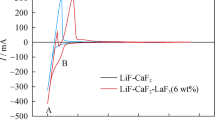Abstract
Activation of the lattice disorder in molten cryolite–alumina electrolyte increases the population of free ions and of ionized oxide fragments. This results in collapse of ionic resistance and partial reduction.
Similar content being viewed by others
References
Diller, I. M., US Pat., 3,244,604, April 5, 1966.
Breckenridge, R. G., J. Chem. Phys., 16, 959 (1948).
Breckenridge, R. G., J. Chem. Phys., 18, 913 (1950).
Zarzycki, J., Conf. Non Crystalline Solids, 117 (edit. by Frechette) (Wiley, 1960).
Levy, H. A., Agron, P. A., Bredig, M. A., and Danford, M. D., Ann. NY Acad. Sci., 79, 762 (1960).
Stern, H., and Holmes, G. T., J. Electrochem. Soc., 105, 478 (1958).
Pearson, T. G., Royal Institute of Chemistry, Monograph No. 3 (London, 1955).
Rolin, N., Ann. de Physique, 6, 970 (1951).
Foster, P. A., and Frank, W. B., J. Electrochem. Soc., 107, 997 (1960).
Author information
Authors and Affiliations
Rights and permissions
About this article
Cite this article
DILLER, I. Activated Molten Salt. Nature 224, 877–879 (1969). https://doi.org/10.1038/224877a0
Received:
Revised:
Issue Date:
DOI: https://doi.org/10.1038/224877a0
- Springer Nature Limited





